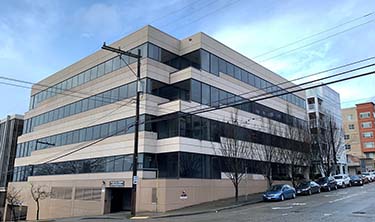|
Subscribe / Renew |
|
|
Contact Us |
|
| ► Subscribe to our Free Weekly Newsletter | |
| home | Welcome, sign in or click here to subscribe. | login |
Real Estate Buzz
| |
 Brian Miller Real Estate Editor |
February 1, 2024
On the Block: City aims to aid office conversions
Everyone's talking about converting empty old office buildings to apartments. But, as we all know, that process is fraught, cumbersome and expensive. You have to find exactly the right building, at the right price (preferably a big discount), with the right floorplates, windows, light wells, elevator/stair cores, etc.
The city, to its credit, is listening to building owners and developers contemplating such residential flips. Some of those latter parties have told me that there should be no design reviews for such projects; and that the Mandatory Housing Affordability fee — already paid once for newer buildings, at least — shouldn't be levied again, or at all.
Done, and done. Early last month, the city issued a SEPA determination of non-significance for a pair of proposed tweaks to municipal land-use code. Those are: 1) no design review for such conversions; and 2) no MHA fee. Simple.
The city's Office of Planning & Community Development has endorsed the measure, which awaits city council action sometime this year. By way of a prelude last year, the OPCD also conducted a design competition to promote such projects. That followed Mayor Bruce Harrell's announcement of his multi-pronged downtown activation plan. Bullet points then included the mission to “explore the potential for repurposing downtown office buildings for housing and other uses.”
Here let's note that we're not talking only about downtown. The zoning changes also apply to any commercial zone anywhere in the city, which encompasses mixed-use, midrise and high-rise areas. Basically that's anywhere near transit or deemed an urban village. And, more broadly, you're not going to find old offices to convert in the middle of Laurelhurst or Magnolia. NIMBYs need not clutch their pearls.
Since the OPCD's rather fanciful competition last summer (topped by Hybrid Architecture's co-living scheme for the Mutual Life Building in Pioneer Square), the DJC has first reported on two actual office conversion plans. Both, filed by building owners, are examples of what the city wants to encourage.
Stream Real Estate is planning about 68 units in the empty 1980s Queen Anne Plaza building, in the Uptown neighborhood. And Martin Selig Real Estate will convert the remaining offices at the fairly new Third & Lenora, once claimed by WeWork, to some 160 luxury apartments.
The public comment period has passed for the proposed zoning changes; appeals to the city Hearing Examiner are due by today. The changes will next be considered by a council subcommittee, then the full city council. No schedule has been set for that.
If the list of conversions begins to grow even before then, we can probably expect some sort of retroactive language to extend the same benefit to all.
Last month came an office conversion report from RentCafe/Yardi Matrix, which placed greater Seattle at No. 15 on the national list of residential flips. I don't trust that report at all (it includes a long-dead 618-unit scheme in Renton), which merely ranks plans — my italics — both current and future, instead of actual realized projects or permits issued.
The more legitimate conclusion is the level of interest in such conversions, meaning the hatching of plans. By that measure, such plans have increased fourfold nationally from 2021 to a potential 55,300 units created by such proposals. For what it's worth, we supposedly have 972 units planned here via conversions, and another 2,138 units in the offing.
But I do not believe those numbers. As a subject of conversation, and now legislation, sure. Conversions are in the air.
The report finds the biggest numbers, unsurprisingly, in older cities with lots of high-rises that were obsolete even pre-pandemic — namely New York, Chicago, Washington, DC … and, strangely, Dallas? Bear in mind that, well before COVID-19, slender old Wall Street towers were being converted to rentals and condos. (That was caused in part by banks and brokerages moving to newer homes in Midtown, with larger floorplates and better A/C.)
Here, as I've written before, some older downtown office buildings may have the right floorplates, but they're often also in need of seismic retrofits. Many such conversion candidates are on the city's notorious URM list — i.e. unreinforced masonry structures. Those building owners have previously petitioned the city for aid in underwriting the cost of such seismic work … but nothing has come of that so far.
So while the zoning tweaks may be essential for office conversions, further city incentives may be necessary, too.
Got a tip? Contact DJC real estate editor Brian Miller at brian.miller@djc.com or call him at (206) 219-6517.
Previous columns:
- On the Block: A new operator at Pacific Place. But will new tenants follow?, 01-18-2024
- On the Block: Life-science flip for 2601 Elliott, post-Zulily, looks more likely, 12-14-2023
- On the Block: Our post-pandemic recovery? Some lessons from New York, 11-30-2023
- On the Block: A Third Avenue demo plan and its neighbors, 10-19-2023
- On the Block: City ponders fate of white elephant at Seattle Center, 10-12-2023
- On the Block: Could these Uptown offices convert?, 09-28-2023
- On the Block: King County contemplates SoDo bus/jail combo, 08-24-2023
- On the Block: From American Apparel to chicken fingers?, 08-03-2023



